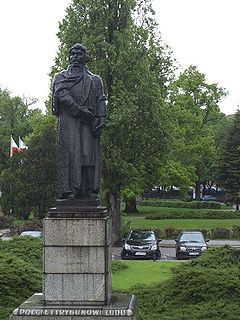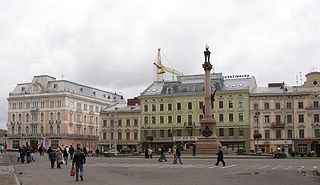 W
WAdam Bernard Mickiewicz was a Polish poet, dramatist, essayist, publicist, translator and political activist. He is regarded as national poet in Poland, Lithuania and Belarus. A principal figure in Polish Romanticism, he is one of Poland's "Three Bards" and is widely regarded as Poland's greatest poet. He is also considered one of the greatest Slavic and European poets and has been dubbed a "Slavic bard". A leading Romantic dramatist, he has been compared in Poland and Europe to Byron and Goethe.
 W
WAdam Mickiewicz Alley is one of the main streets of downtown district in Bydgoszcz, where several buildings are registered on the Kuyavian-Pomeranian Voivodeship Heritage List.
 W
WThe Adam Mickiewicz Institute is a government-sponsored organization funded by Poland's Ministry of Culture and National Heritage, and headquartered at ulica Mokotowska 25 in Warsaw.
 W
WThe Adam Mickiewicz Library and Dramatic Circle is a non-profit membership-based organization founded in 1895. It is the oldest Polish American organization in Western New York and is the oldest surviving Polish library in Buffalo. The library holds approximately 12,000 volumes with 400 hand copied plays. The bar serves over 50 different imported beers with a large Polish selection. The "Circle" is home to most of Torn Space Theater's productions and a large annual Dyngus Day party, as well as other cultural events.
 W
WThe Adam Mickiewicz monument in Gorzów Wielkopolski is a notable Gorzów Wielkopolski statue, located near a cross of Lwów Eaglets Street and Władysław Sikorski Street. The monument was designed by Józef Gosławski.\
 W
WAdam Mickiewicz Monument in Kraków,, is one of the best known bronze monuments in Poland, and a favourite meeting place at the Main Market Square in the Old Town district of Kraków.
 W
WThe Adam Mickiewicz Monument, also known as the Adam Mickiewicz Column,, is a Neo-classical column commemorating the Polish Romantic poet Adam Mickiewicz (1798–1855) located at the Mickiewicz Square in the centre of Lviv, Ukraine, and opened in 1904.
 W
WThe Adam Mickiewicz Monument in Vilnius, Lithuania is a monument in the vicinity of the Saint Anne's Church and the Bernardine Monastery, by Maironio Street along the shores of the Neris River.
 W
WAdam Mickiewicz Monument is a monument dedicated to Adam Mickiewicz at the Krakowskie Przedmieście in the Śródmieście district of Warsaw, Poland. The Neo-Classicist monument was constructed in 1897–1898 by sculptor Cyprian Godebski.
 W
WThe Adam Mickiewicz Museum of Literature is a museum named for noted Polish poet and essayist Adam Mickiewicz in Warsaw, Poland. It was established in 1950.
 W
WAdam Mickiewicz Museum is a historic house museum dedicated to the life of Adam Mickiewicz, renowned Polish poet. It is located in the district of Beyoğlu, on the European side of Istanbul, Turkey.
 W
WThe Adam Mickiewicz Museum is a small museum dedicated to Polish poet Adam Mickiewicz (1798–1855). It is located within the Polish Library in Paris in the 4th arrondissement of Paris at 6, Quai d'Orleans, Paris, France.
 W
WThe Mickiewicz Battalion was a volunteer battalion of the International Brigades during the Spanish Civil War. It formed part of the XIII International Brigade from 27 October 1937 until 23 September 1938, when the International Brigades were disbanded.
 W
WThe Mickiewicz Legion or the Polish Legion was a military unit formed on March 29, 1848 in Rome by one of the most notable Polish poets, Adam Mickiewicz, to take part in the liberation of Italy.
 W
WThe Mickiewicz Square is one of the main squares in the city of Lviv, Ukraine.
 W
WThe Portrait of Adam Mickiewicz on the Ayu-Dag Cliff is an oil portrait of Adam Mickiewicz by Walenty Wańkowicz created from 1827 to 1828. Since 1925 it has been in the collection of the National Museum, Warsaw.
 W
WCelina Szymanowska was a daughter of the Polish composer and pianist Maria Agata Szymanowska and the wife of the Polish Romantic poet Adam Mickiewicz.
 W
WMaria Szymanowska was a Polish composer and one of the first professional virtuoso pianists of the 19th century. She toured extensively throughout Europe, especially in the 1820s, before settling permanently in St. Petersburg. In the Russian imperial capital, she composed for the court, gave concerts, taught music, and ran an influential salon.